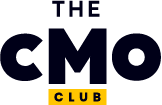Personalization is key: Tailor your email content to individual preferences for higher engagement and conversion rates.
Measure success with KPIs: Define clear KPIs to track performance and refine your email marketing strategy.
Take advantage of A/B testing: Regularly test different elements of your emails to optimize open rates and overall effectiveness.
Choose the right platform: To optimize your campaigns, select an email marketing tool that integrates well with your existing systems.
In an era obsessed with TikTok trends and social media spend, email continues to quietly deliver one of the most cost-effective returns in your entire marketing mix. Why? It’s personal. It’s permission-based. And when done right, it converts like nothing else.
Still, inboxes are more crowded than ever, and stale tactics won’t cut it. That’s why we’re breaking down 10 essential email marketing strategies from segmentation to subject lines that move the needle. Whether you’re launching your first campaign or levelling up a legacy program, this guide is your roadmap to better open rates, click-throughs, and long-term customer love.
What is Email Marketing?
Email marketing is when businesses use email as a channel to promote products and services and foster relationships with their ideal customer profile (ICP). What makes email such a great marketing channel is its return on investment, the ease of monitoring, and the insights businesses get from measuring campaign performance.
Email marketing can take many forms, from newsletters designed to keep recipients in the loop and build brand identity or as part of a series aimed at inciting a specific action, like scheduling a demo or registering for a webinar.
Email marketing can be helpful in many scenarios, including:
- Cultivating customer relationships: Foster connections with existing customers and build relationships with new customers through personalized engagement.
- Boosting brand awareness: Create content that allows you to live rent-free in the minds of potential customers so when they’re ready to buy, you’re already on their radar.
- Sharing content: Share relevant blog posts or valuable resources with your audience according to their needs and interests.
- Generating leads: Encourage subscribers to share their personal information in exchange for valuable assets so you can send them more targeted content likely to pique their interest.
- Promoting your products: Email marketing is a great way to highlight your products and boost your ecommerce business.
- Nurturing leads: Send helpful content to your customers’ inboxes to support their goals and help them succeed.
Benefits of Email Marketing
With its proven track record of driving conversions and revenue, email simply can't be ignored, as evidenced by the following email marketing statistics.
According to HubSpot's State of Marketing 2024 Report:
- For every $1 invested in email marketing, businesses earn $36 in return.
- 14% of survey respondents reported that email marketing delivered the highest ROI of all digital marketing tactics.
This ROI can manifest in different ways, including:
- Increased sales: Automated emails, such as an abandoned cart, re-engagement, or post-purchase messages, generate up to 30 times more revenue per recipient than standard campaigns (Klaviyo’s 2024 Benchmark Report). Few channels can match the ROI of tactical email campaigns designed to nurture prospects by showcasing product benefits, social proof, promotions, pricing, coupons, bundles, and making the sale.
- Improved customer loyalty: Personalized email marketing can promote customer loyalty. According to Salesforce, 65% of consumers say they will likely remain loyal to a brand that offers a more personalized experience.
- Increased brand awareness: Email marketing is an excellent avenue for building brand identity. In fact, in CampaignMonitor’s recent study of 1,000 small business owners, email marketing was ranked the second most effective channel for building brand awareness.
5 Types of Marketing Emails with Examples
Whether you're looking to drive sales, nurture customer relationships, or educate your audience, there’s an email for that. Below are six evergreen marketing emails — with examples — to inspire your next campaign.
1. Welcome Emails
Welcome emails are your brand’s first impression and they set the tone for everything that follows. These messages are typically sent immediately after a user subscribes or signs up, making them a key moment to introduce your value, build trust, and encourage the next step.
Pro tips:
- Deliver value immediately: Include a discount, free resource, or quick-start guide.
- Clarify what’s next: Let recipients know what kind of emails they’ll get and how often.
- Make it personal: Use dynamic fields to insert the user’s name and reference how they signed up.
Example: Airbnb’s welcome email is clean, friendly, and instantly positions the user as part of a global community reinforcing their brand while guiding users toward their first booking.
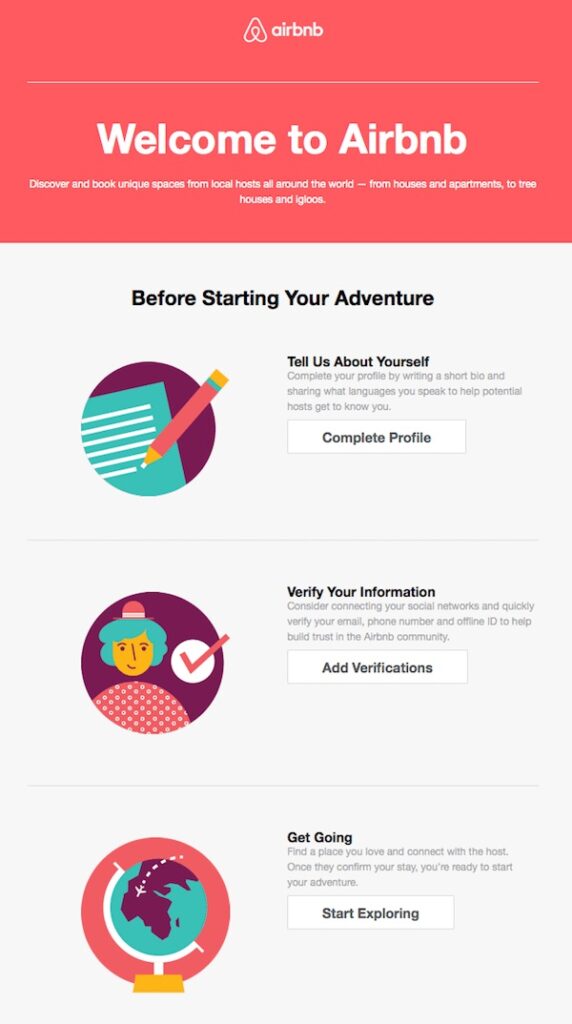
2. Lead Nurturing Emails
Lead nurturing emails are designed to move prospects through your funnel. These are the targeted messages you send between awareness and purchase—educating, engaging, and subtly guiding the decision-making process.
Pro tips:
- Map content to funnel stages: Deliver different emails based on where leads are in the buyer journey.
- Leverage automation: Use behavioral triggers to time messages for maximum impact.
- Focus on value over pitch: Think product demos, testimonials, or helpful guides—not just “buy now” CTAs.
Example: Salesforce’s nurturing series blends product education with client success stories, helping move enterprise leads closer to conversion.
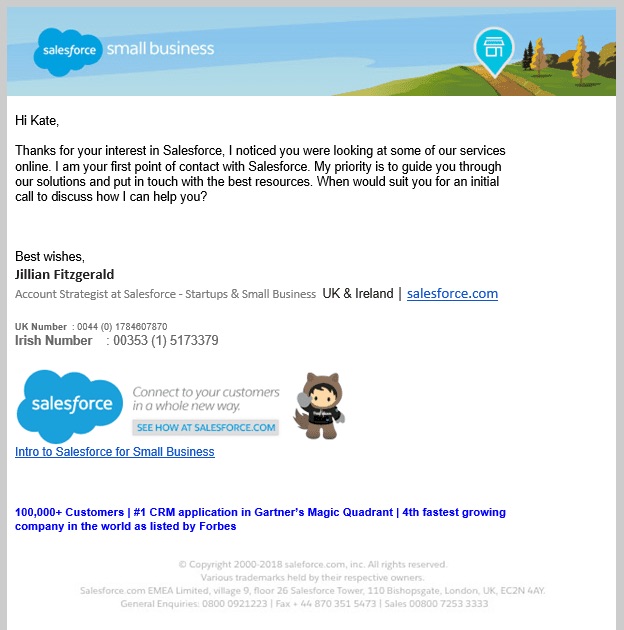
3. Newsletter Emails
Newsletters are your ongoing touchpoint—the pulse of your content and brand. They can be educational, editorial, or promotional, but the goal is always consistent engagement and long-term relationship building.
Pro tips:
- Segment for relevance: Customize content based on user interests or behavior.
- Optimize the layout: Make it skimmable with headlines, bullets, and strong visuals.
- Prioritize value: Make your newsletter worth opening every time—no fluff.
Example: The Morning Brew newsletter is a stellar example of an informational email blast. It provides bite-sized insights into business and tech, delivered in a friendly format that keeps subscribers looking forward to it landing in their inbox.
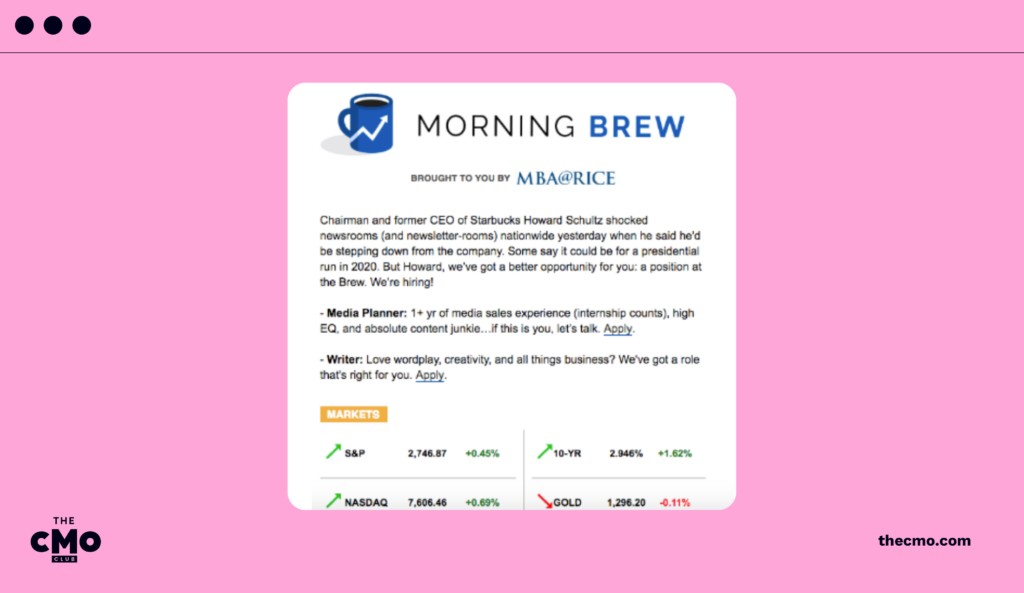
4. Dedicated Emails
Also known as standalone emails, these are focused messages about a single topic—like a product launch, webinar invite, or flash sale. They’re ideal when you want to highlight one thing, clearly and persuasively.
Pro tips:
- Get to the point fast: Readers should know within seconds what the email is about.
- Use eye-catching visuals: Hero images or GIFs in your email design can help your CTA stand out.
- Limit distractions: Avoid linking out to too many places. Drive toward one clear action.
Example: Notion’s product launch emails use elegant design and sharp email copy to showcase new features, boosting excitement and adoption.
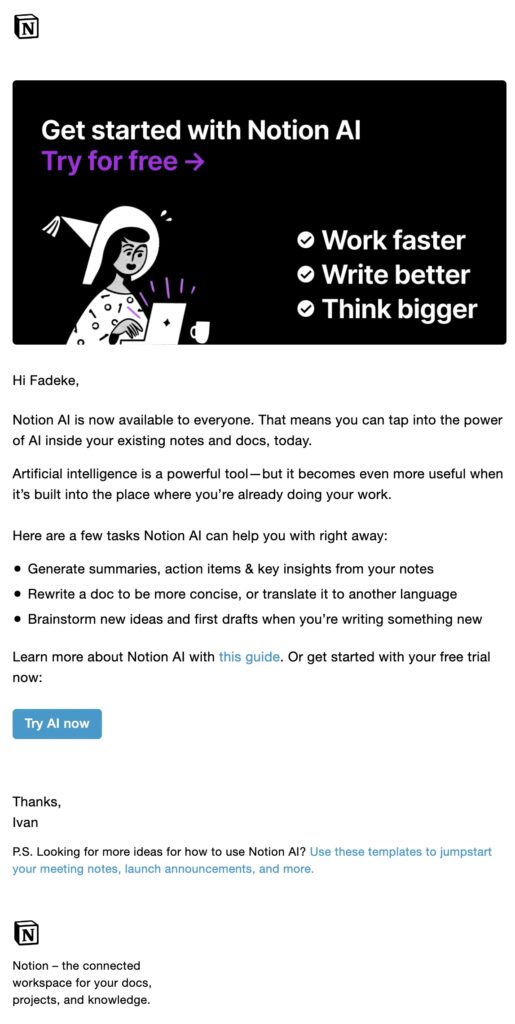
4. Reengagement Emails
Reengagement emails are your last-ditch effort to win back inactive subscribers or churned customers. Whether it’s a gentle reminder or an irresistible offer, these emails aim to revive interest.
Pro tips:
- Be direct: Use subject lines like “Still interested?” or “We miss you.”
- Offer an incentive: Discounts or bonuses can reignite attention.
- Ask for feedback: Use this moment to learn why they disengaged and how to improve.
Example: Grammarly sends out reengagement emails that highlight missed opportunities and offer personalized usage stats creating FOMO and encouraging reactivation.
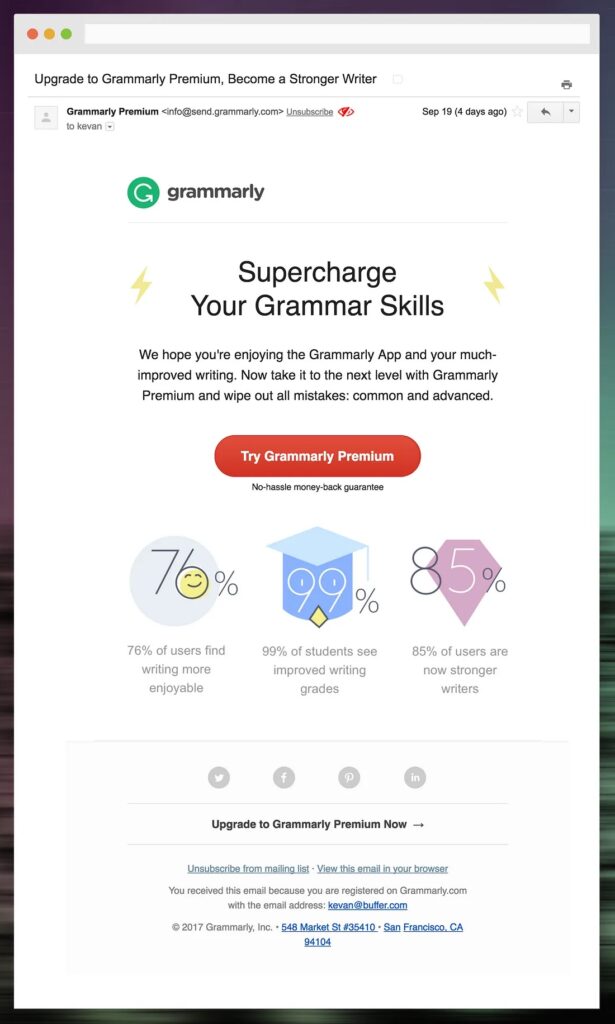
How To Get Started With Your Email Marketing Campaign
Launching a successful email marketing campaign doesn’t happen by accident–it requires a strategic approach, with careful consideration of each step and how they work together to achieve your desired results. Here are some pointers to get you started.
1. Align with Leadership on Your Goals
Before launching any campaign, you need to make sure you’re aligned with leadership. What will this campaign set out to do, and how will you get there? Define clear goals and map out how they align with the overall business objectives to make sure you’re on the same page.
Pro tips for driving leadership alignment:
- Be specific: Define SMART (Specific, Measurable, Achievable, Relevant, Time-bound) goals to maintain focus.
- Communicate effectively: Make sure key stakeholders understand how email marketing fits into the broader strategy.
- Revisit goals regularly: Periodically review your goals to adjust for changes in market conditions or business priorities.
Aligning with leadership ensures that your campaign is strategic and supported at all levels.
2. Define Your Target Audience
Targeting the right audience is key to making sure your emails connect with readers and spark real engagement.
Segment your audience based on demographics, behavior, or interests, to make sure you’re delivering relevant messages. Having a solid understanding of your audience improves engagement rates and boosts conversions.
Pro tips for defining your target audience:
- Use data insights: Leverage customer data to create detailed buyer personas.
- Segment your list: Divide your audience into smaller segments for more personalized messaging.
- Refine as you go: Analyze and update your target audience over time as you gather more insights.
Defining your audience helps you deliver the right message to the right people, maximizing the impact of your campaign.
3. Pick Your Preferred Email Marketing Platform
Your choice of platform determines the ease of managing your campaigns and the effectiveness of your outreach, so choose wisely.
A good platform streamlines processes and provides valuable data insights.
Consider features like automation, integrations, analytics, and ease of use, depending on what’s important to you.
Pro tips for choosing the best email marketing software:
- Consider scalability: Choose a platform that can grow with your business.
- Look for integrations: Make sure your email marketing platform can integrate with your CRM or other marketing tools.
- Test usability: Opt for a user-friendly interface that simplifies campaign management.
The right platform helps you manage your campaigns effectively, allowing for automation and detailed performance tracking.
4. Choose an Email Campaign Type
Different email campaigns—such as promotional, transactional, or nurture campaigns—serve different purposes. Choosing the right one ensures you're targeting the right message at the right time.
Pro tips: when deciding on campaign types:
- Match campaign type to goals: Use promotional emails for sales and nurture emails for long-term engagement.
- Consider customer journey stage: Send relevant emails based on where your audience is in their buying process.
- Monitor performance: Regularly assess which campaign types perform best and adjust accordingly.
The right campaign type makes for more meaningful interactions and maximizes the impact on your audience, driving better results.
5. Build Your Email List
Before you can launch any campaign, you need an audience to send it to. Building a high-quality email list isn’t about adding as many addresses as possible. It’s about attracting the right subscribers with the highest potential for engagement and conversion.
Pro tips for growing a targeted, valuable list:
- Offer value upfront: Use lead magnets like ebooks, webinars, or exclusive discounts to entice sign-ups.
- Use smart opt-in forms: Place sign-up forms strategically across your website including the homepage, blog, exit-intent pop-ups, and keep the form fields minimal.
- Leverage existing channels: Promote your email list on social media, in blog posts, and across customer touchpoints.
A strong, permission-based list is the foundation of every successful email campaign. It ensures your messages reach people who actually want to hear from you, reducing bounce rates, boosting open rates, click-throughs, and long-term ROI.
6. Segment Your List
One-size-fits-all emails don’t cut it anymore. If you’re still blasting the same message to your entire list, you’re leaving conversions (and credibility) on the table. Segmentation lets you tailor emails based on subscriber behavior, preferences, and demographics to boost relevance, engagement, and ROI.
Pro tips for smart segmentation:
- Start with the basics: Break down your list by lifecycle stage, industry, or job role. B2B SaaS? Segment by company size or use case.
- Use behavioral data: Trigger campaigns based on actions—downloads, purchases, email opens, or site visits.
- Layer in engagement: Identify your most active (and at-risk) subscribers to send more targeted re-engagement or loyalty emails.
Segmentation is table stakes for email marketers who want to move beyond vanity metrics and drive actual results.
8. Create Your Email Campaign
Launching a full-scale campaign without a test run is a mistake, one that can lead to missed opportunities and wasted resources. A pilot email campaign is a smaller-scale trial of your full campaign, designed to test audience engagement, content relevance, and platform functionality.
Pro tips for running an effective pilot campaign:
- Test different variables: Experiment with subject lines, content formats, and CTAs to see what works.
- Analyze open and click rates: Pay close attention to key performance metrics to evaluate success.
- Gather feedback: Use the pilot to identify areas for improvement.
A pilot campaign allows you to test the waters and fine-tune your approach before going all in.
9. Test Your Email Campaign
Using data from your pilot campaign to refine your approach ensures that your full campaign is optimized for success. This includes tweaking subject lines, finding the best time to send emails, adjusting content, and improving audience targeting.
Pro tips when optimizing for results from your pilot campaign:
- Review key metrics: Focus on open rates, click-through rates, and conversions to get a sense of what to keep and what to change.
- Tweak based on feedback: Make necessary changes to the email format, content, or CTAs based on pilot performance.
- Segment audience more effectively: Use insights from the pilot to better target audience segments.
Using pilot data to refine your marketing campaign can maximize the impact and increase your chances of success.
10. Measure Your Results and Optimize
Measuring results allows you to track the success of your email marketing campaign and optimize future efforts. Continuous optimization ensures that you maximize ROI and improve engagement over time.
Without proper email analytics software, you'll know how well your campaign performed and where you need improvements.
Pro tips when measuring your campaign results:
- Track KPIs consistently: Focus on open rates, click-through rates, and conversions to gauge success.
- A/B test regularly: Experiment with subject lines, designs, and content to improve performance.
- Adjust based on insights: Use data to continuously tweak and refine your emails for better results.
Optimizing based on real-time data helps improve engagement and locks in long-term campaign success.
Important Email Regulations
Navigating the world of email marketing requires a solid understanding of the regulations governing how you collect, store, and use subscriber data. Compliance with these regulations not only protects your business from legal repercussions but also helps build trust with your audience. Here are two key regulations you should be aware of.
1. GDPR Compliance
The General Data Protection Regulation (GDPR) is a comprehensive data protection law that governs how organizations handle personal data in the European Union. Marketers need to obtain consent from individuals before collecting their data and gives users the right to access, modify, and delete their information.
Pro tips for staying compliant:
- Obtain explicit consent: Ensure that your sign-up forms include clear language about data usage and require users to actively consent to receive emails.
- Make privacy policies accessible: Clearly outline how you collect, use, and protect subscriber data, and provide easy access to this information.
- Facilitate data access: Offer subscribers the ability to access, modify, or delete their information upon request.
Staying compliant with GDPR not only helps you avoid hefty fines but also demonstrates your commitment to protecting your subscribers' privacy and not spamming them, contributing to stronger customer relationships.
2. CAN-SPAM Compliance
The CAN-SPAM Act is a U.S. law that applies to commercial email messages. It establishes requirements for senders and gives recipients the right to have emails stopped from being sent to them. Compliance with CAN-SPAM helps you protect your reputation and maintain a positive relationship with your audience.
Pro tips for staying compliant:
- Include a clear unsubscribe option: Every email should provide a straightforward way for recipients to opt out of future communications.
- Use accurate sender information: Your name and email address should clearly identify your business.
- Avoid deceptive subject lines: Make sure your subject lines accurately reflect the content of your emails to avoid misleading recipients.
Understanding and complying with the CAN-SPAM Act is an important yet often overlooked part of email marketing.
Email Marketing Best Practices
When it comes to email marketing, we believe in letting creativity lead. However, several factors can elevate a good email to greatness. Let’s look closer at the MVPs of email marketing best practices.
1. Avoid Spam Filters
It doesn’t matter how clever the content of your emails is if they’re not making their way to your audience’s inbox. Knowing how to craft your emails to avoid being in the spam folder is critical to any successful email marketing campaign.
Avoiding spam filters boosts open rates and engagement and enhances your marketing effectiveness. This helps build stronger relationships with your audience, increases brand credibility, and drives conversions.
Pro tips for skirting spam filters:
- Build and maintain a clean email list: To maintain a high-quality, engaged email subscriber base and prioritization from email service providers (ESP), you must regularly scrub and sanitize your email lists. Not to worry—this task can easily be automated via your chosen email marketing platform (along with other email marketing automations). Another best practice is the double opt-in, which involves sending new subscribers a confirmation email containing a unique link they must click to verify their identity and confirm their consent. You can automate follow-up emails reminding users to verify if needed.
- Use clear and honest subject lines: Whatever type of email you’re sending out, be it a welcome email, promotional email, or email newsletter, it’s a good idea to avoid misleading or overly promotional language in email subject lines to avoid spam filters and turn off recipients.
- Monitor engagement metrics: Monitor open rates, click-through rates, and unsubscribe rates to gauge engagement and adjust your strategy as needed.
Implementing best practices enhances deliverability so you can ensure your messages reach your intended audience, foster engagement, and drive sales.
2. Use Personalization to Stand Out
Using a first name in a subject line doesn't cut it anymore. Armed with first-party data, marketing teams can now deliver hyper-personalized content straight to a prospect’s inbox.
Brands are excelling with AI-driven product recommendations, location-based details, and customized images to deliver dynamic content. According to Litmus’s 2024 State of Email Trends Report, more than 80% of respondents saw at least some performance improvement by personalizing subject lines, incorporating live or real-time content, and using dynamic content.
Pro tips for hyper-personalization:
- Leverage AI for personalized recommendations: Use AI to recommend products based on customer preferences, making emails more relevant and increasing the chances of conversion.
- Segment your audience effectively: Organize your email lists for marketing by location, behavior, or purchase history to deliver tailored content.
- Incorporate dynamic content: Implement personalized images and offers that change based on user data, like location and purchase history, to create an interactive and tailored experience.
User data is a veritable goldmine if you know how to use it. Crafting personal, relevant, and engaging emails leads to higher conversions and stronger customer relationships.
3. Use Email Marketing Templates
Creating an email involves multiple steps: content, design, development, and often email marketing automation. According to Litmus’s State of Email Workflows Report, 39% of marketers simplify their workflow by replacing text and images in existing email templates, significantly reducing their workload. Templates provide a structured format that lets you focus on quality content rather than starting the process from scratch each time.
Email marketing templates typically include pre-designed layouts for different types of campaigns, such as newsletters, promotional offers, or event invitations. They incorporate consistent branding elements, like logos, colors, and fonts, which help maintain brand identity while reducing the time spent on design. Not only do templates improve brand recognition, but they also make measuring results and analyzing campaign performance easier.
Pro tips for creating email marketing templates:
- Customize templates for each audience: While templates provide structure, you should still make sure to tailor content according to the intended audience.
- Test and optimize: Regularly A/B test different template designs and layouts to identify which formats resonate best with your audience, then refine accordingly.
- Keep it mobile-friendly: With 41% of views coming from mobile devices, optimizing emails for mobile is essential.
Use email marketing templates to streamline the design process and maintain consistency. This allows you to focus on delivering quality content that engages and delights your audience.
Email Marketing FAQs
When is the best time to send marketing emails?
Mid-week mornings (Tuesdays to Thursdays between 9–11 a.m.) often yield the best results, but it depends on your audience. Test and analyze your own data to identify when your specific subscribers are most responsive.
What is a good open rate for email marketing?
A solid open rate typically falls between 20%–30%, though benchmarks vary by industry. SaaS emails targeting engaged lists can often perform better—especially with personalized subject lines and optimized send times.
What is A/B testing in email marketing?
A/B testing (or split testing) compares two versions of an email elements such as subject lines, CTAs, and layouts to see which performs better. It's a simple way to optimize for opens, clicks, and conversions using real audience data.
How much does email marketing cost?
Costs range from free (using basic plans) to thousands per month for enterprise tools. Pricing depends on your list size, platform, automation needs, and whether you use freelancers, agencies, or in-house resources.
Build a Successful Email Marketing Campaign
Email remains one of the most potent and effective channels for SaaS marketers to generate revenue, drive conversions, and build valuable customer relationships at scale. Here are three of our top email marketing tips to keep in mind:
- Prioritize personalized and relevant email content over being in constant contact with your audience. Personalization and effective segmentation enhance customer engagement and drive higher conversion rates.
- Consistently measuring and optimizing email marketing efforts through defined KPIs and A/B testing leads to higher open rates, increased conversions, and strengthens brand loyalty.
- Choose your email marketing platform carefully. The right tool will integrate seamlessly with your CRM and other email marketing software, making tasks like building drip sequences and dynamic segmentation simple through intuitive UIs and pre-built functionality.
Looking for more insights to level up your B2B email marketing game? Subscribe to The CMO newsletter for the latest email marketing tips, tactics, and expert perspectives delivered to your inbox weekly.
